Identifying New Copper Mineralization via Multispectral Remote Sensing (MSRS) and Short-Wave Infrared (SWIR) Spectral Analysis in Dingyang, Western Gangdese Belt, Xizang
Abstract
1. Introduction
2. Study Area
3. Datasets and Methods
3.1. Data Acquisition and Preprocessing
3.1.1. Sentinel 2 Remote Sensing Image
3.1.2. SWIR Spectrum
3.2. Methods of Analysis
3.2.1. Multispectral Alteration Anomaly Extraction
3.2.2. SWIR Spectral Analysis
4. Result
4.1. Alteration Anomaly Extraction
4.2. Identification and Distribution of Altered Minerals
4.3. SWIR Spectral Features of Sericite
5. Discussion
5.1. Sericite SWIR Spectral Indicators for Mineral Exploration
5.2. Spectral Feature-Based Geological Connotation Method (SFGCM)
5.3. Discovery of New Mineralisation
6. Conclusions
- (1)
- Sentinel-2 data identified Al-OH, Mg-OH, carbonate alterations, and ferric contamination anomalies. Diagnostic exploration criteria were defined based on the SWIR spectral characteristics of targets: Pos2200 < 2203 nm, Dep2200 > 0.3, SWIR − IC > 1.6.
- (2)
- The Spectral Feature-Based Geological Connotation Method (SFGCM) integrates remote sensing anomalies with SWIR spectral parameters to quantify alteration intensity and delineate ore-related anomalies.
- (3)
- SFGCM refines alteration anomalies, delineates mineralization centers, and discovers new prospects, providing a validated approach for targeting ore-forming cores in spectral-based exploration.
- (4)
- This study discovers new mineralized areas, expands the mineral resource potential of the Zhunuo ore concentration area, and demonstrates a replicable workflow for regional resource exploration.
Author Contributions
Funding
Data Availability Statement
Acknowledgments
Conflicts of Interest
References
- Hou, Z.Q.; Zheng, Y.C.; Yang, Z.M.; Yang, Z.S. Metallogenesis of continental collision setting: Part I. Gangdese Cenozoic porphyry Cu-Mo systems in Tibet. Miner. Depos. 2012, 31, 647–670. (In Chinese) [Google Scholar] [CrossRef]
- Tang, J.X.; Liu, H.F.; Lang, X.H.; Zhang, J.S.; Zheng, W.B.; Ying, L.J. Minerogenetic series of ore deposits in the east part of the Gangdise metallogenic belt. Acta Geosci. Sin. 2012, 33, 393–410. (In Chinese) [Google Scholar]
- Zheng, Y.Y.; Wu, S.; Ci, Q.; Chen, S.Y.; Shi, S.D.; Chen, X.; Liu, P.; Li, J.Z. Metallogenic series and exploration breakthroughs of Zhunuo ore district in Xizang. Miner. Depos. 2024, 43, 1295–1315. (In Chinese) [Google Scholar] [CrossRef]
- Zheng, Y.Y. The discovery of Zhunuo porphyry copper deposit in Tibet and its significance. Earth Sci. Front. 2006, 13, 233–239. (In Chinese) [Google Scholar]
- Li, J.Z.; Wu, S.; Lin, Y.B.; Jiang, Z.Y.; Yi, J.Z.; Jiang, G.W.; Zhao, Y.Y. Alteration-mineralization style and prospecting potential of Cimabanshuo porphyry copper deposit in Tibet. J. Earth Sci. 2022, 47, 2219–2244. (In Chinese) [Google Scholar] [CrossRef]
- Ci, Q.; Zheng, Y.Y.; Wu, S.; Liu, P.; Zhao, Y.Y.; Gong, F.Z.; Du, Z.Z.; Hou, Y.T. Discovery and Significance of Beimulang Porphyry Cu-Mo Deposit, Xizang. J. Earth Sci. 2025, 50, 1305–1318. (In Chinese) [Google Scholar] [CrossRef]
- Tagwai, M.G.; Jimoh, O.A.; Shehu, S.A.; Zabidi, H. Application of GIS and remote sensing in mineral exploration: Current and future perspectives. World J. Eng. 2024, 21, 487–502. [Google Scholar] [CrossRef]
- Liu, L.; Yin, C.T.; Khalil, Y.S.; Hong, J.; Feng, J.L.; Zhang, H.S. Alteration mapping for porphyry Cu targeting in the western Chagai belt, Pakistan, using ZY1-02D spaceborne hyperspectral data. Econ. Geol. 2024, 119, 331–353. [Google Scholar] [CrossRef]
- Rani, K. Mineral exploration using remote sensing. In Remote Sensing for Geophysicists; CRC Press: Boca Raton, FL, USA, 2025; pp. 79–94. [Google Scholar] [CrossRef]
- Habashi, J.; Moghadam, H.J.; Oskouei, M.M.; Pour, A.B.; Hashim, M. PRISMA hyperspectral remote sensing data for mapping alteration minerals in sar-e-châh-e-shur region, birjand, Iran. Remote Sens. 2024, 16, 1277. [Google Scholar] [CrossRef]
- Chen, Q.; Cai, D.; Zhao, Z.; Yang, X.; Wang, Y.; Jiang, X.; Xu, T. Alteration Information Extraction and Mineral Prospectivity Mapping in the Laozhaiwan Area Using Multisource Remote Sensing Data. Remote Sens. 2025, 17, 2178. [Google Scholar] [CrossRef]
- Zhao, Z.F.; Zhang, G.; Chen, Q.; Cai, D.Y.; Meng, F.J.; Long, X.Y.; Zhang, T.; Wang, Y.Y.; Xu, T.; Yang, H.Y.; et al. Gold exploration using multi-source remote sensing data in the northern part of the Wa State, Myanmar. Ore Geol. Rev. 2025, 183, 106703. [Google Scholar] [CrossRef]
- Yang, D.Y.; Shao, H.X.; Chang, H.L.; Zhang, R.X.; Ding, B.Z. Landsat 8 and ASTER remote sensing data for ore prospecting in the postmasburg manganese ore field, South Africa. Earth Sci. Inform. 2025, 18, 102. [Google Scholar] [CrossRef]
- Hu, B.; Xu, Y.Y.; Wan, B.; Wu, X.C.; Yi, G.H. Hydrothermally altered mineral mapping using synthetic application of Sentinel-2A MSI, ASTER and Hyperion data in the Duolong area, Tibetan Plateau, China. Ore Geol. Rev. 2018, 101, 384–397. [Google Scholar] [CrossRef]
- Zhu, Y.; Wu, Z. A synergistic PCA and CA fractal approach for high-precision extraction of mineral alteration anomalies from ASTER remote sensing data. Geocarto Int. 2025, 40, 2476599. [Google Scholar] [CrossRef]
- Zhang, G.; Zhao, Z.; Zhang, X.; Wu, X.; Zheng, Y.; Feng, L.; Huang, Z. Comprehensive Multi-Source remote sensing data integration for enhanced mineralization alteration extraction and geological structure interpretation in the Lala region of Sichuan Province. Ore Geol. Rev. 2024, 168, 106032. [Google Scholar] [CrossRef]
- Yang, Z.M.; Hou, Z.Q.; Yang, Z.S.; Qu, H.C.; Li, Z.Q.; Liu, Y.F. Application of short wavelength infrared (SWIR) technique in exploration of poorly eroded porphyry Cu district: A case study of Niancun ore district, Tibet. Miner. Depos. 2012, 31, 699–717. (In Chinese) [Google Scholar] [CrossRef]
- Bi, R.; Wang, F.Y.; Zhao, J.K.; Zhang, K.X.; Wu, J.Q.; Liu, Y.S.; Guo, Y.H. Study of short-wave infrared spectroscopy (SWIR) on hydrothermal chlorite in the Tongshan porphyry Cu-Mo deposit, Heilongjiang. Ore Geol. Rev. 2025, 186, 106775. [Google Scholar] [CrossRef]
- Wang, Y.X.; Xiao, B.; Wang, Y.; Wang, Y.; Fu, X.R.; Zhao, J.X.; Wang, H.; Cao, G.S. Hydrothermal alteration and shortwave infrared (SWIR) spectroscopy exploration of the Jinwozi gold deposit in the Beishan Orogenic Belt, NW China. Ore Geol. Rev. 2025, 185, 106820. [Google Scholar] [CrossRef]
- Zhou, T.J.; Xu, L.G.; Liu, K.; Zhang, W.; Fu, X.R.; Yuan, P. Alteration mineralogy of the Xiajiadian Au deposit in southern Qinling, China: Application of Short Wavelength Infra-Red (SWIR) spectroscopy for vein-type Au exploration. Ore Geol. Rev. 2025, 184, 106753. [Google Scholar] [CrossRef]
- Wu, Z.Z.; Chen, G.; Jiang, Z.Y.; Zheng, Y.Y.; Chen, X.; Gao, S.B. Diagnostic implications of shortwave-thermal infrared characteristics of typical alteration minerals for mineral exploration in continental volcanic arcs: A case study of the Zhalong Cu-Sn polymetallic deposit, Tibet. Ore Geol. Rev. 2025, 106760. [Google Scholar] [CrossRef]
- Hou, Z.Q.; Gao, Y.F.; Qu, X.M.; Rui, Z.Y.; Mo, X.X. Origin of adakitic intrusives generated during mid-Miocene east–west extension in southern Tibet. Earth Planet. Sci. Lett. 2004, 220, 139–155. [Google Scholar] [CrossRef]
- Zheng, Y. Finding and significances of Chongjiang porphyry copper (molybdenum, aurum) deposit, Tibet. Earth Sci. J. China Univ. Geosci. 2004, 29, 333–339. [Google Scholar]
- Zheng, Y.Y.; Zhang, G.Y.; Xu, R.K.; Gao, S.B.; Pang, Y.C.; Gao, L.; Du, A.D.; Shi, Y.R. Geochronologic constraints on magmatic intrusions and mineralization of the Zhunuo porphyry copper deposit in Gangdese, Tibet. Chin. Sci. Bull. 2007, 52, 3139–3147. [Google Scholar] [CrossRef]
- Zheng, Y.Y.; Sun, X.; Gao, S.B.; Wu, S.; Xu, J.; Jiang, J.S.; Chen, X.; Zhao, Z.Y.; Liu, Y. Metallogenesis and the minerogenetic series in the Gangdese polymetallic copper belt. J. Asian Earth Sci. 2015, 103, 23–39. [Google Scholar] [CrossRef]
- Yang, Z.M.; Goldfarb, R.; Chang, Z.S. Generation of postcollisional porphyry copper deposits in southern Tibet triggered by subduction of the Indian continental plate. Soc. Econ. Geol. Spec. Publ. 2016, 19, 279–300. [Google Scholar]
- Sun, X.; Zheng, Y.Y.; Li, M.; Ouyang, H.T.; Liu, Q.Q.; Jing, X.K.; Sun, G.P.; Song, Q.J. Genesis of Luobuzhen Pb–Zn veins: Implications for porphyry Cu systems and exploration targeting at Luobuzhen-Dongshibu in western Gangdese belt, southern Tibet. Ore Geol. Rev. 2017, 82, 252–267. [Google Scholar] [CrossRef]
- Sun, X.; Zheng, Y.Y.; Xu, J.; Huang, L.H.; Guo, F.; Gao, S.B. Metallogenesis and ore controls of Cenozoic porphyry Mo deposits in the Gangdese belt of southern Tibet. Ore Geol. Rev. 2017, 81, 996–1014. [Google Scholar] [CrossRef]
- Liu, P.; Wu, S.; Zheng, Y.Y.; Wang, X.Y.; Kang, Y.M.; Yan, J.; Gu, Y.; Liu, X.F.; Gong, F.Z.; Zhao, Y.Y.; et al. Geology and factors controlling the formation of the newly discovered Beimulang porphyry Cu deposit in the western Gangdese, southern Tibet. Ore Geol. Rev. 2022, 144, 104823. [Google Scholar] [CrossRef]
- Shi, S.D.; Chen, S.Y.; Luo, S.J.C.; Ren, H.; Jiang, X.J. Petrogenesis and Metallogenic Significance of the Demingding Mo-Cu Porphyry Deposit in the Gangdese Belt, Xizang: Insights from U-Pb and Re-Os Geochronology and Geochemistry. Minerals 2024, 14, 1232. [Google Scholar] [CrossRef]
- Wu, S.; Zheng, Y.Y.; Xu, B.; Jiang, G.W.; Yi, J.Z.; Liu, X.F.; Zheng, S.L.; Li, L. Heterogeneous mantle associated with asthenosphere and Indian slab metasomatism: Constraints on fertilization of porphyry Cu mineralization in Tibetan orogen. Ore Geol. Rev. 2022, 140, 104601. [Google Scholar] [CrossRef]
- Zheng, Y.Y.; Sun, X.; Gao, S.B.; Wang, C.M.; Zhao, Z.Y.; Wu, S.; Li, J.D.; Wu, X. Analysis of stream sediment data for exploring the Zhunuo porphyry Cu deposit, southern Tibet. J. Geochem. Explor. 2014, 143, 19–30. [Google Scholar] [CrossRef]
- Wu, S.; Zheng, Y.Y.; Sun, X.; Liu, S.A.; Geng, R.R.; You, Z.M. Origin of the Miocene porphyries and their mafic microgranular enclaves from Dabu porphyry Cu–Mo deposit, southern Tibet: Implications for magma mixing/mingling and mineralization. Int. Geol. Rev. 2014, 56, 571–595. [Google Scholar] [CrossRef]
- Wu, S.; Zheng, Y.Y.; Sun, X. Subduction metasomatism and collision-related metamorphic dehydration controls on the fertility of porphyry copper ore-forming high Sr/Y magma in Tibet. Ore Geol. Rev. 2016, 73, 83–103. [Google Scholar] [CrossRef]
- Wang, L.F.; Wu, S.; Lai, X.D.; Yang, W.L.; Sun, R.L.; Liu, P.; Yang, Y.D.; Ren, Y.X. The Short-Wave Infrared (SWIR) Spectral Exploration Identification and Indicative Significance of the Yixingzhai Gold Deposit, Shanxi Province. Minerals 2025, 15, 83. [Google Scholar] [CrossRef]
- Han, J.S.; Chu, G.B.; Chen, H.Y.; Hollings, P.; Sun, S.Q.; Chen, M. Hydrothermal alteration and short wavelength infrared (SWIR) characteristics of the Tongshankou porphyry-skarn Cu-Mo deposit, Yangtze craton, Eastern China. Ore Geol. Rev. 2018, 101, 143–164. [Google Scholar] [CrossRef]
- Chen, H.Y.; Zhang, S.T.; Chu, G.B.; Zhang, Y.; Cheng, J.M.; Tian, J.; Han, J.S. The short wave infrared (SWIR) spectral characteristics of alteration minerals and applications for ore exploration in the typical skarn-porphyry deposits, Edong ore district, eastern China. Acta Petrol. Sin. 2019, 35, 3629–3643. [Google Scholar] [CrossRef]
- Feng, Y.Z.; Xiao, B.; Li, R.C.; Deng, C.Z.; Han, J.S.; Wu, C.; Li, G.H.; Shi, H.L.; Lai, C.K. Alteration mapping with short wavelength infrared (SWIR) spectroscopy on Xiaokelehe porphyry Cu-Mo deposit in the Great Xing’an Range, NE China: Metallogenic and exploration implications. Ore Geol. Rev. 2019, 112, 103062. [Google Scholar] [CrossRef]
- Liu, L.; Chen, J.; Li, X.; Zhao, T.; Li, S.; Sun, L.; Chen, J. Short wavelength infrared (SWIR) reflectance spectroscopy of alteration minerals of Qibaoshan ore district, Shandong Province, China. Ore Geol. Rev. 2024, 165, 105868. [Google Scholar] [CrossRef]
- Leng, C.B.; Wang, D.Z.; Yu, H.J.; Tian, F.; Zhang, X.C. Mapping hydrothermal alteration zones with short wavelength infrared (SWIR) spectra and magnetic susceptibility at the Pulang porphyry Cu-Au deposit, Yunnan, SW China. Miner. Depos. 2024, 59, 699–716. [Google Scholar] [CrossRef]
- Ren, H.; Zheng, Y.Y.; Wu, S.; Wang, D.; Zuo, L.; Chen, L.; Gao, F.; Wei, J.G.; Wang, S.C.; Shu, D.F.; et al. Short-wavelength infrared characteristics and composition of white mica in the Demingding porphyry Cu-Mo deposit, Gangdese belt, Tibet: Implications for mineral exploration. Ore Geol. Rev. 2024, 164, 105833. [Google Scholar] [CrossRef]
- Zheng, S.L.; Wu, S.; Zheng, Y.Y.; Chen, L.; Wei, C.; Huang, P.C.; Jing, X.K.; Yu, Z.Y.; He, C.T.; Ren, H. Identifying potential porphyry copper mineralization at the Zhu’nuo ore-cluster district in western Gangdese, southern Tibet: Insights from shortwave infrared (SWIR) spectrometry and geochemical anomalies. Ore Geol. Rev. 2022, 151, 105202. [Google Scholar] [CrossRef]
- Bai, L.Y.; Dai, J.J.; Liu, Z.B.; Song, Y.; Wang, N.; Chen, W. Discovery and prospecting of the Zhule mineralization spot in Xizang: Evidence from short-wave infrared alteration mineral mapping. Geol. Explor. 2025, 61, 0221–0229. [Google Scholar] [CrossRef]
- Duke, E.F. Near infrared spectra of muscovite, Tschermak substitution, and metamorphic reaction progress: Implications for remote sensing. Geology 1994, 22, 621–624. [Google Scholar] [CrossRef]
- Herrmann, W.; Blake, M.; Doyle, M.; Huston, D.; Kamprad, J.; Merry, N.; Pontual, S. Short wavelength infrared (SWIR) spectral analysis of hydrothermal alteration zones associated with base metal sulfide deposits at Rosebery and Western Tharsis, Tasmania, and Highway-Reward, Queensland. Econ. Geol. 2001, 96, 939–955. [Google Scholar] [CrossRef]
- Jones, S.; Herrmann, W.; Gemmell, J.B. Short Wavelength Infrared Spectral Characteristics of the HW Horizon: Implications for Exploration in the Myra Falls Volcanic-Hosted Massive Sulfide Camp, Vancouver Island, British Columbia, Canada. Econ. Geol. 2005, 2, 273–294. [Google Scholar] [CrossRef]
- Zhang, S.T.; Chu, G.B.; Cheng, J.M.; Zhang, Y.; Tian, J.; Li, J.P.; Sun, S.Q.; Wei, K.T. Short wavelength infrared (SWIR) spectroscopy of phyllosilicate minerals from the Tonglushan Cu-Au-Fe deposit, Eastern China: New exploration indicators for concealed skarn orebodies. Ore Geol. Rev. 2020, 122, 103516. [Google Scholar] [CrossRef]
- Zhang, Z.X.; Dai, J.J.; Wang, X.G.; Hu, Z.H.; Wan, X.; Peng, B.; Zhao, L.X. Shortwave infrared characteristics of muscovite from giant Shimensi tungsten deposit in northern Jiangxi Province and implication to exploration. Miner. Depos. 2023, 42, 116–127. (In Chinese) [Google Scholar]
- Guo, N.; Thomas, C.; Tang, J.X.; Tong, Q.X. Mapping white mica alteration associated with the Jiama porphyry-skarn Cu deposit, central Tibet using field SWIR spectrometry. Ore Geol. Rev. 2019, 108, 147–157. [Google Scholar] [CrossRef]
- Wang, L.; Percival, J.B.; Hedenquist, J.W.; Hattori, K.; Qin, K.Z. Alteration mineralogy of the Zhengguang epithermal Au-Zn deposit, northeast China: Interpretation of shortwave infrared analyses during mineral exploration and assessment. Econ. Geol. 2021, 116, 389–406. [Google Scholar] [CrossRef]
- Duba, D.; Williams-Jones, A.E. The application of illite crystallinity, organic matter reflectance, and isotopic techniques to mineral exploration; a case study in southwestern Gaspe, Quebec. Econ. Geol. 1983, 78, 1350–1363. [Google Scholar] [CrossRef]
- Li, X.X.; Zhou, T.F.; White, N.C.; Fan, Y.; Zhang, L.J.; Xie, J.; Liu, Y.N.; Xiao, X. Formation of the Fanshan lithocap and implications for exploration in the Luzong Basin, Anhui Province, China. Ore Geol. Rev. 2020, 118, 103314. [Google Scholar] [CrossRef]
- Xiao, B.; Chu, G.B.; Feng, Y.Z. Short-wave infrared (SWIR) spectral and geochemical characteristics of hydrothermal alteration minerals in the Laowangou Au deposit: Implications for ore genesis and vectoring. Ore Geol. Rev. 2021, 139, 104463. [Google Scholar] [CrossRef]
- Balaram, V. New Frontiers in analytical techniques—Opportunities and challenges in geochemical research. J. Geol. Soc. India 2021, 97, 331–334. [Google Scholar] [CrossRef]
- Liu, Q.L.; Yang, J.; Mao, X.C.; Liu, Z.K.; Deng, M.; Chen, Y.X.; Liu, W.K. Identifying geochemical anomalies using a new method of Yang Chizhong-spatial scan statistic. Comput. Geosci. 2023, 178, 105392. [Google Scholar] [CrossRef]
- Guan, Q.F.; Ren, S.L.; Chen, L.R.; Yao, Y.; Hu, Y.; Wang, R.F.; Feng, B.; Gu, L.D.; Chen, W.H. Recognizing multivariate geochemical anomalies related to mineralization by using deep unsupervised graph learning. Nat. Resour. Res. 2022, 31, 2225–2245. [Google Scholar] [CrossRef]
- Yu, S.Y.; Deng, H.; Liu, Z.K.; Chen, J.; Xiao, K.Y.; Mao, X.C. Identification of geochemical anomalies using an end-to-end transformer. Nat. Resour. Res. 2024, 33, 973–994. [Google Scholar] [CrossRef]
- Pang, B.; Wu, S.; Yu, Z.Z.; Liu, Y.; Li, J.B.; Zheng, L.; Chen, H.; Li, X.X.; Shi, G.W. Rapid Exploration Using pXRF Combined with Geological Connotation Method (GCM): A Case Study of the Nuocang Cu Polymetallic District, Tibet. Minerals 2022, 12, 514. [Google Scholar] [CrossRef]
- Zheng, Y.; Gao, S.; Xue, Z.; Sun, X.; Zheng, H.; Ke, Z.; Liu, M. A Method for Identifying and Evaluating Anomalies in Geochemical Exploration Based on Geological Connotation. CN Patent 103345566A, 9 October 2013. (In Chinese). [Google Scholar]
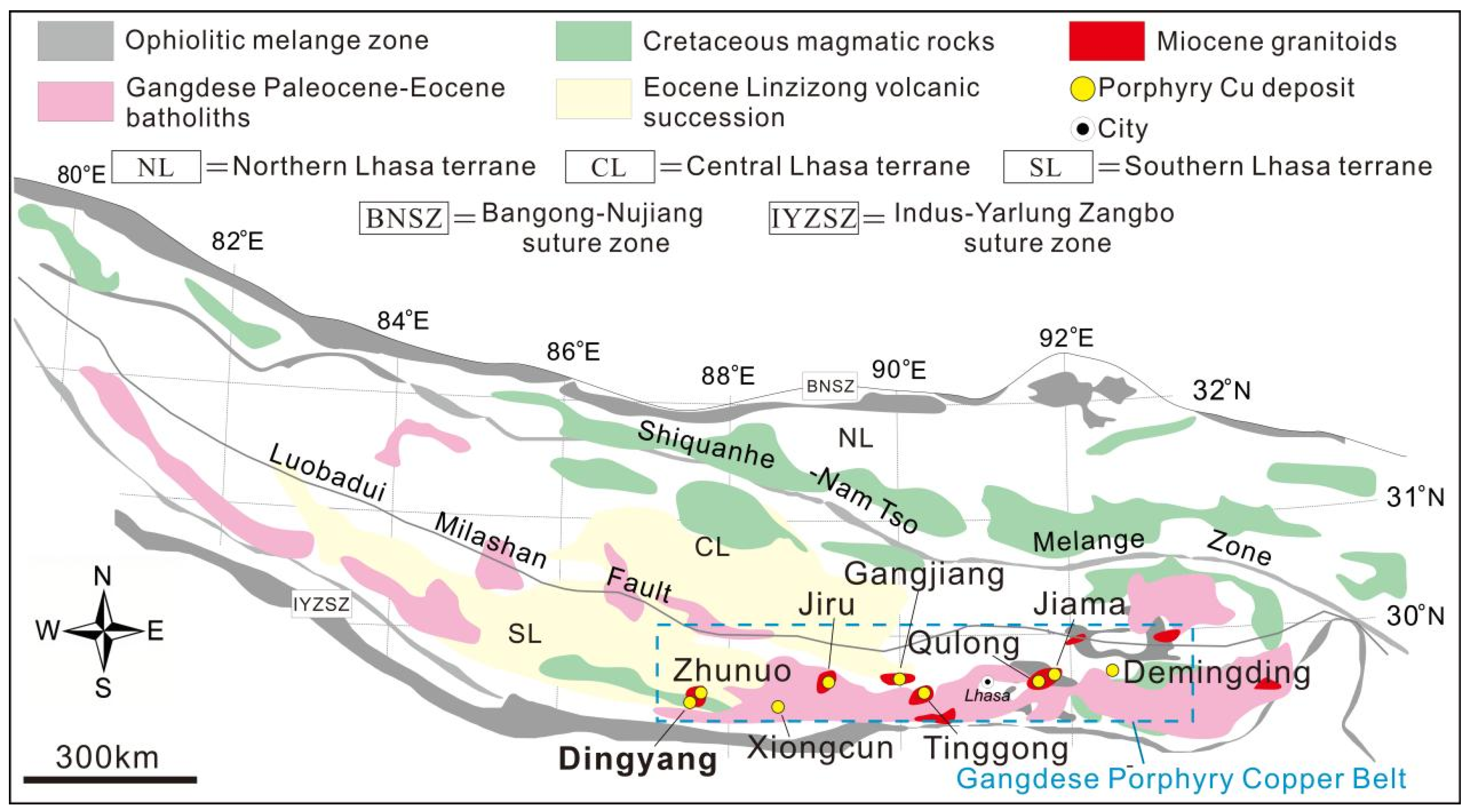
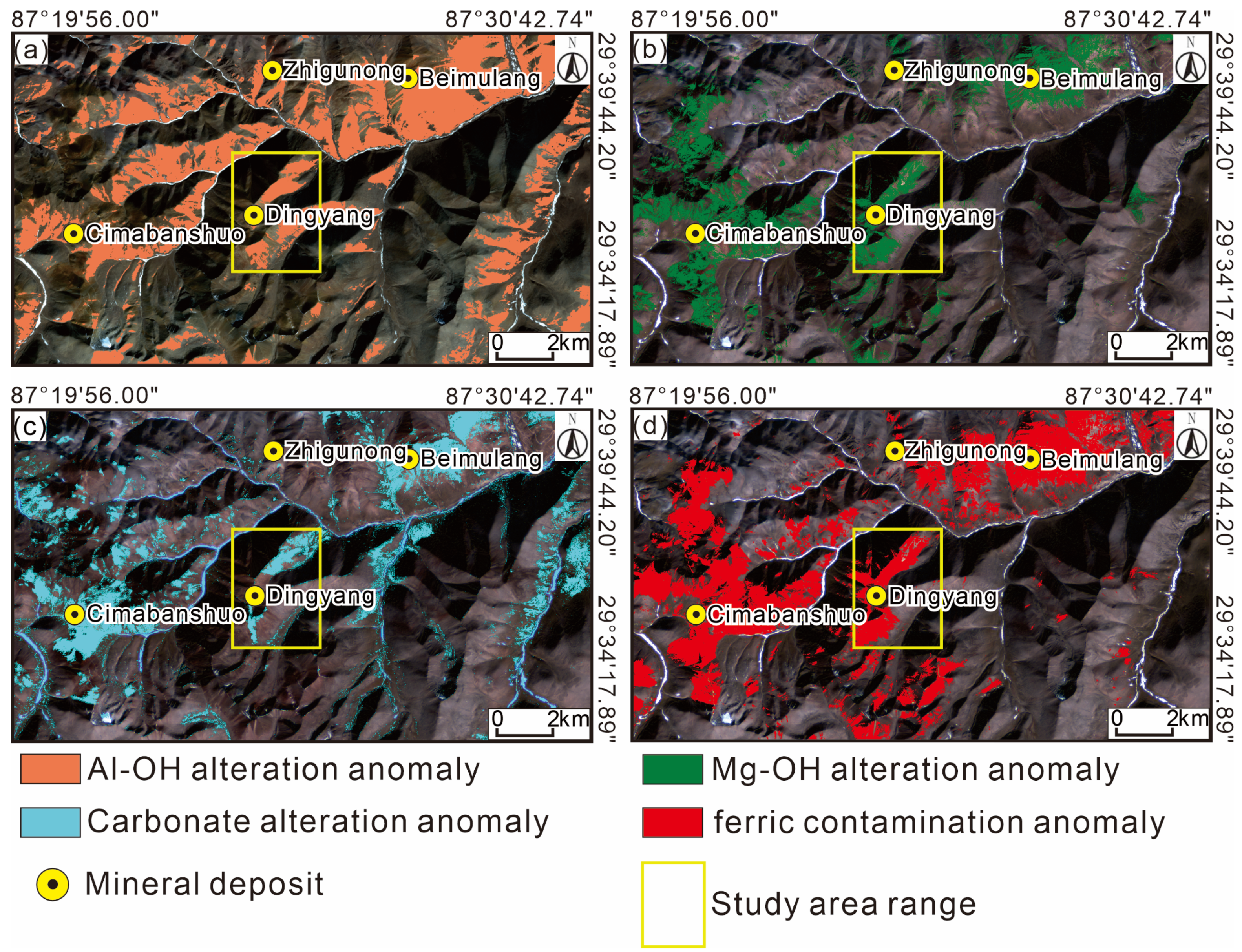
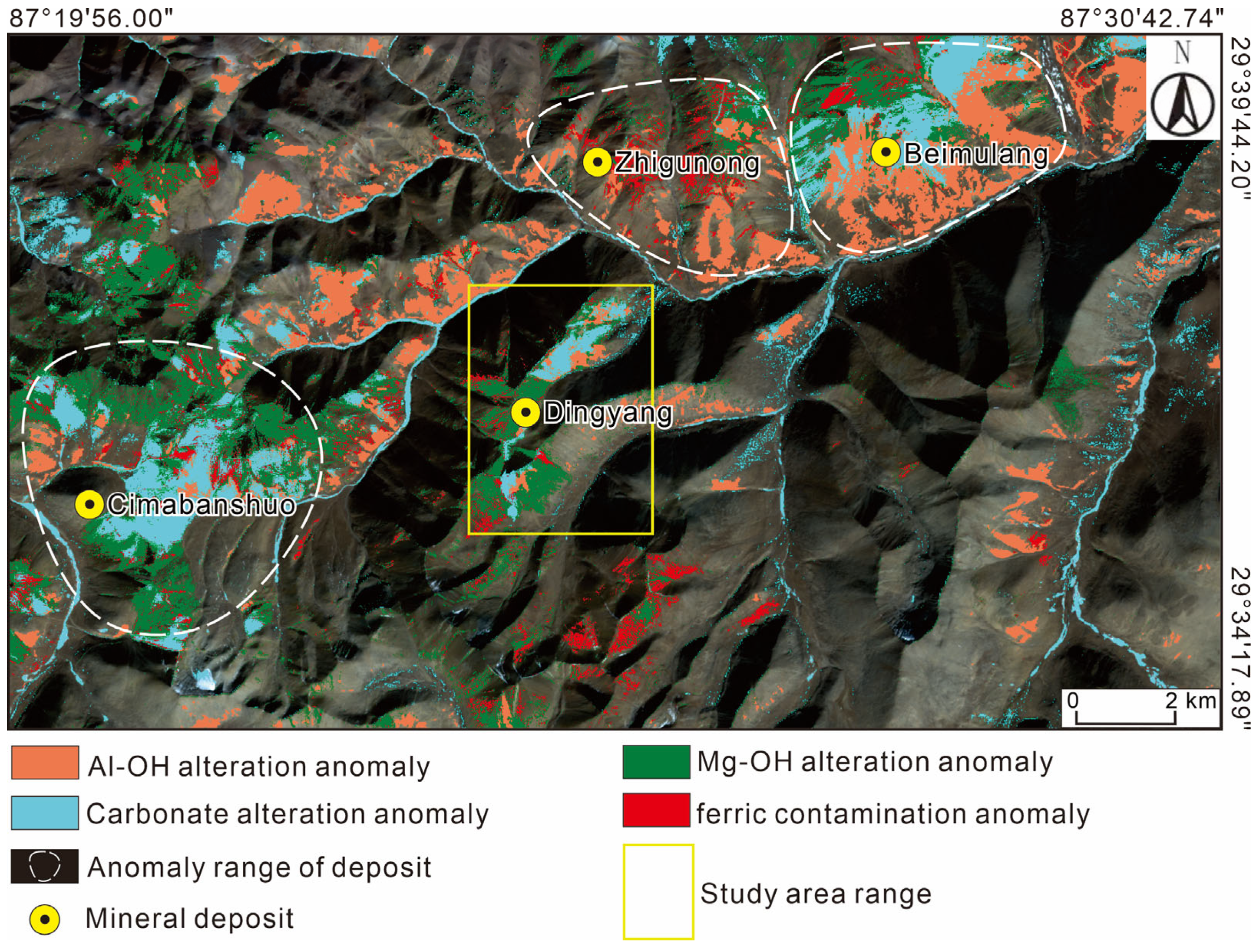
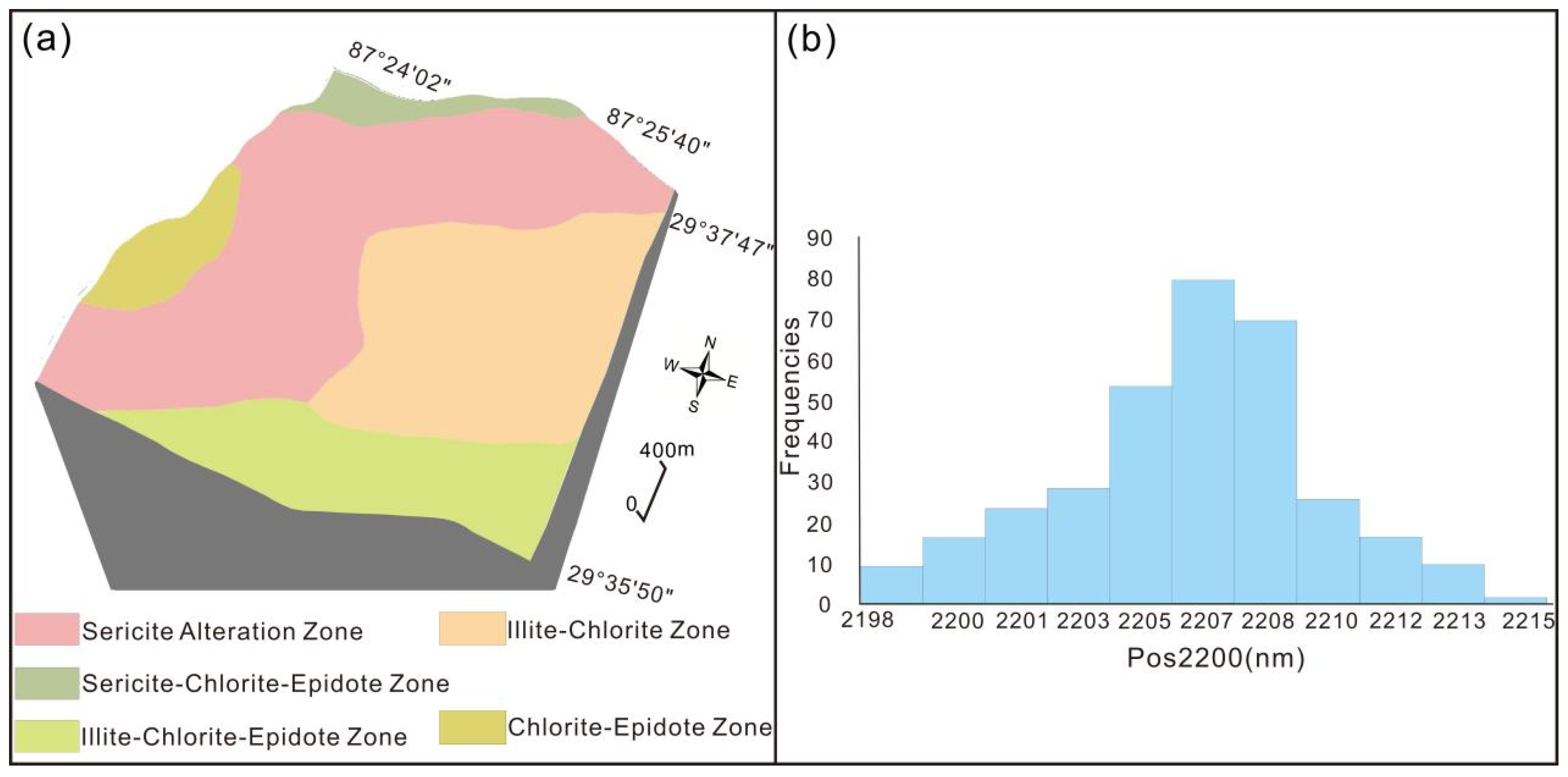
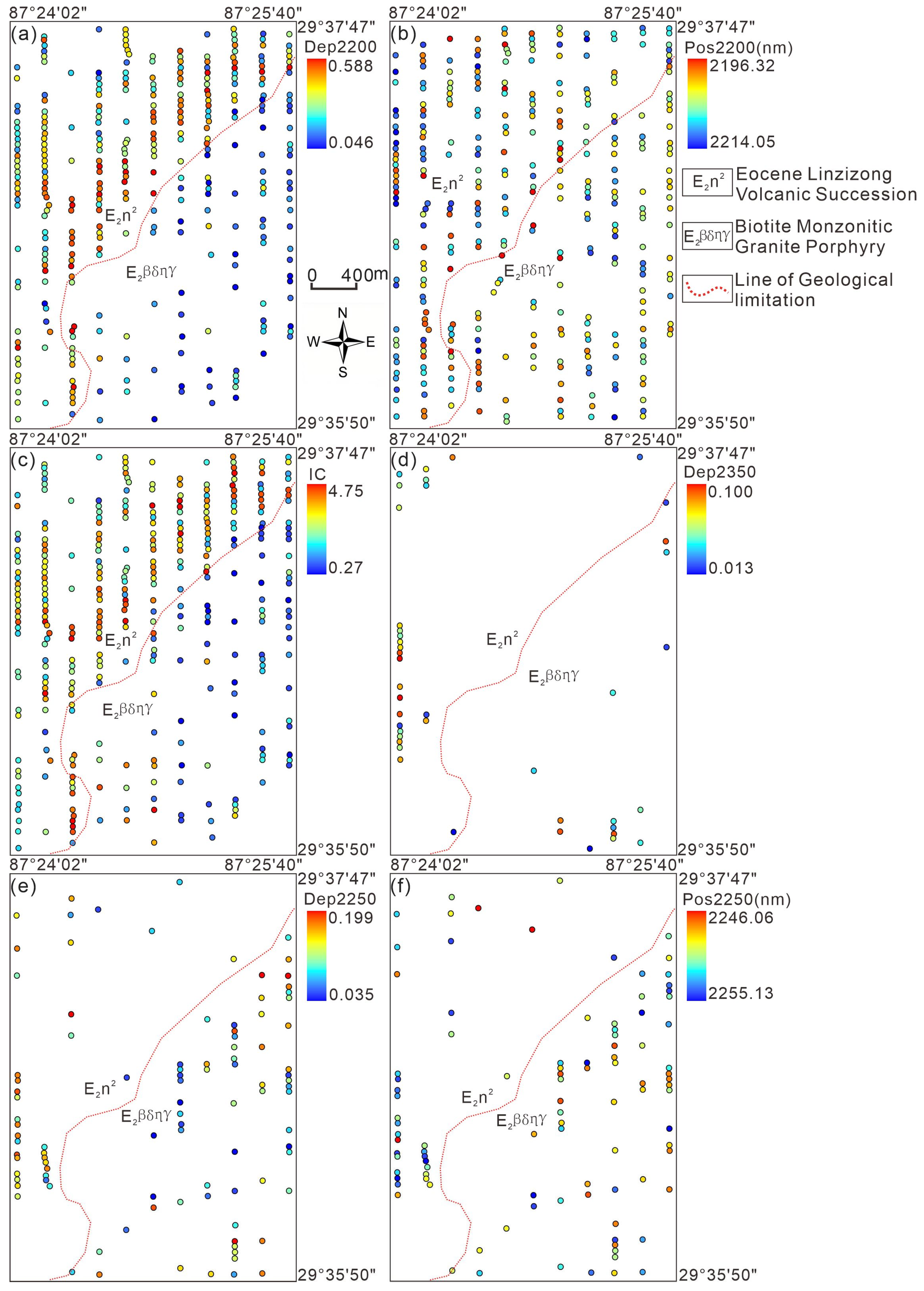
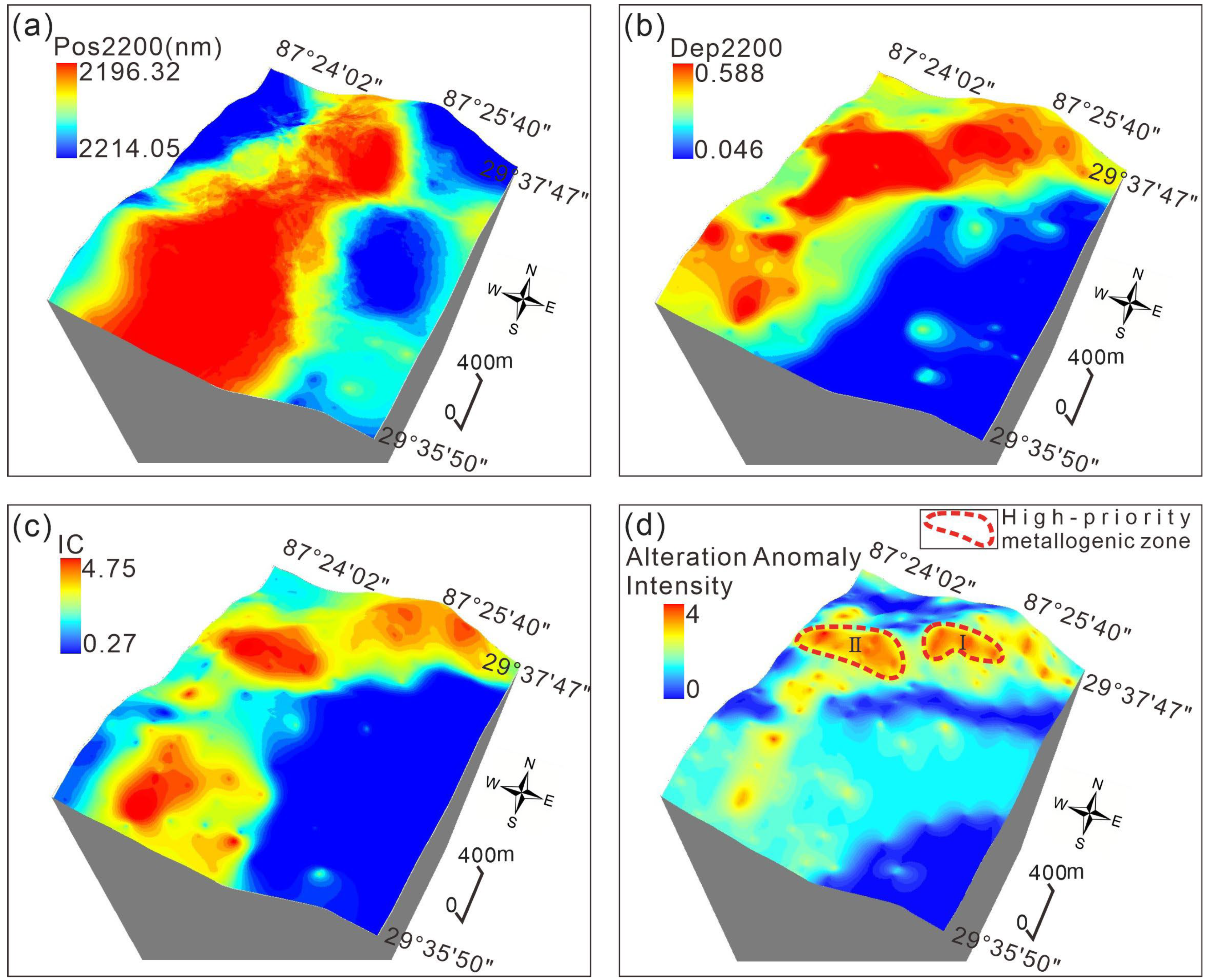

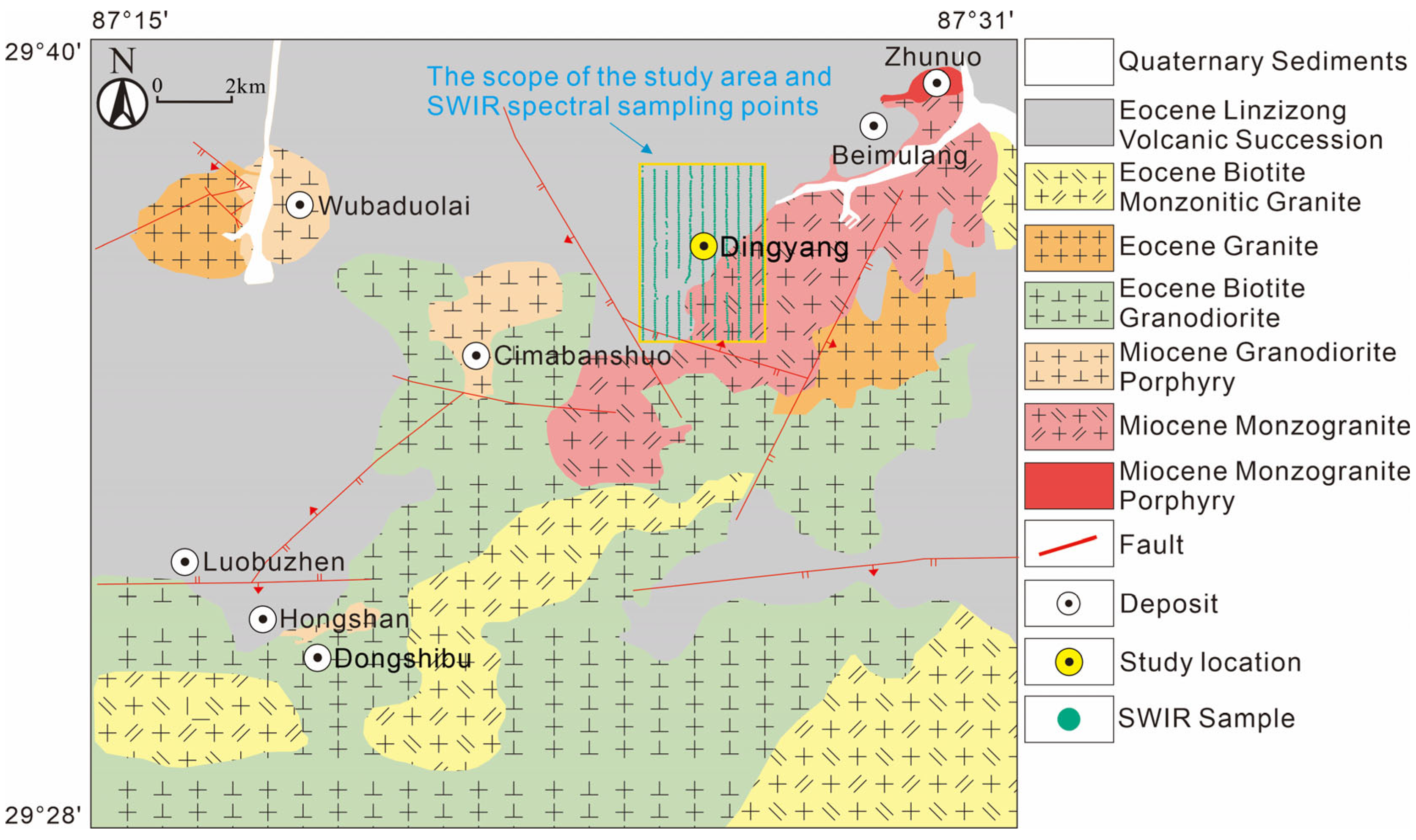
| Data Source | Subsystem | Band Number | Spectral Range (nm) | Spatial Resolution (m) | Spectral Resolution (nm) |
|---|---|---|---|---|---|
| Sentinel-2 | VNIR | 1 | 433–453 | 60 m | |
| 2 | 458–523 | 10 m | |||
| 3 | 543–578 | 10 m | |||
| 4 | 650–680 | 10 m | |||
| 5 | 698–713 | 20 m | |||
| 6 | 733–748 | 20 m | |||
| 7 | 773–793 | 20 m | |||
| 8 | 785–900 | 10 m | |||
| 8 A | 855–875 | 20 m | |||
| 9 | 935–955 | 60 m | |||
| SWIR | 10 | 1360–1390 | 60 m | ||
| 11 | 1565–1655 | 20 m | |||
| 12 | 2100–2280 | 20 m | |||
| ASD TerraSpec Halo | VNIR | 350–1300 | 3 | ||
| SWIR | 1300–2500 | 8.1 |
| Principal Component | Band2 | Band8 | Band11 | Band12 |
|---|---|---|---|---|
| PC1 | 0.20 | 0.50 | 0.66 | −0.52 |
| PC2 | 0.80 | 0.41 | −0.37 | −0.24 |
| PC3 | 0.49 | −0.68 | −0.05 | 0.54 |
| PC4 | −0.29 | 0.33 | −0.66 | 0.61 |
| Principal Component | Band3 | Band4 | Band8A | Band12 |
|---|---|---|---|---|
| PC1 | 0.38 | 0.49 | 0.55 | 0.56 |
| PC2 | 0.58 | 0.45 | −0.10 | −0.68 |
| PC3 | 0.46 | −0.06 | −0.75 | 0.47 |
| PC4 | 0.56 | −0.75 | 0.36 | −0.07 |
| Principal Component | Band3 | Band8 | Band11 | Band12 |
|---|---|---|---|---|
| PC1 | 0.29 | 0.50 | 0.64 | 0.50 |
| PC2 | 0.77 | 0.38 | −0.41 | −0.29 |
| PC3 | 0.29 | −0.43 | −0.39 | 0.76 |
| PC4 | 0.49 | −0.65 | 0.51 | −0.28 |
Disclaimer/Publisher’s Note: The statements, opinions and data contained in all publications are solely those of the individual author(s) and contributor(s) and not of MDPI and/or the editor(s). MDPI and/or the editor(s) disclaim responsibility for any injury to people or property resulting from any ideas, methods, instructions or products referred to in the content. |
© 2025 by the authors. Licensee MDPI, Basel, Switzerland. This article is an open access article distributed under the terms and conditions of the Creative Commons Attribution (CC BY) license (https://creativecommons.org/licenses/by/4.0/).
Share and Cite
Li, Z.; PuBu, Z.; Che, X.; Chen, G.; Wei, J.; Pan, D.; Jiang, X. Identifying New Copper Mineralization via Multispectral Remote Sensing (MSRS) and Short-Wave Infrared (SWIR) Spectral Analysis in Dingyang, Western Gangdese Belt, Xizang. Minerals 2025, 15, 1045. https://doi.org/10.3390/min15101045
Li Z, PuBu Z, Che X, Chen G, Wei J, Pan D, Jiang X. Identifying New Copper Mineralization via Multispectral Remote Sensing (MSRS) and Short-Wave Infrared (SWIR) Spectral Analysis in Dingyang, Western Gangdese Belt, Xizang. Minerals. 2025; 15(10):1045. https://doi.org/10.3390/min15101045
Chicago/Turabian StyleLi, Zhibin, Zhaxi PuBu, Xian Che, Gen Chen, Jiangang Wei, Deng Pan, and Xiaojia Jiang. 2025. "Identifying New Copper Mineralization via Multispectral Remote Sensing (MSRS) and Short-Wave Infrared (SWIR) Spectral Analysis in Dingyang, Western Gangdese Belt, Xizang" Minerals 15, no. 10: 1045. https://doi.org/10.3390/min15101045
APA StyleLi, Z., PuBu, Z., Che, X., Chen, G., Wei, J., Pan, D., & Jiang, X. (2025). Identifying New Copper Mineralization via Multispectral Remote Sensing (MSRS) and Short-Wave Infrared (SWIR) Spectral Analysis in Dingyang, Western Gangdese Belt, Xizang. Minerals, 15(10), 1045. https://doi.org/10.3390/min15101045









